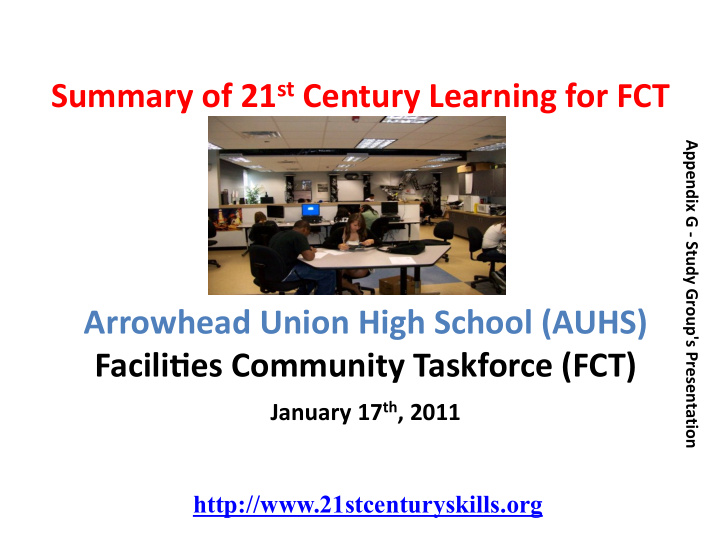



Summary of 21 st Century Learning for FCT Appendix G - Study Group's Presentation Arrowhead Union High School (AUHS) Facili@es Community Taskforce (FCT) January 17 th , 2011 http://www.21stcenturyskills.org
WHY IS 21 st CENTURY LEARNING SIGNIFICANT TO THE TASKFORCE? WHAT IS 21 ST CENTURY LEARNING? WHY IS IT IMPORTANT? HOW IS IT IMPLEMENTED? WHERE IS 21 st CENTURY LEARNING HEADING? HOW WILL STUDENT’S 21 st CENTURY LEARNING TOOLS INFLUENCE EDUCATIONAL FACILITY NEEDS? WHICH 21 st CENTURY LEARNING ISSUES IMPACT FCT? WHAT RECOMMENDATIONS FOR ALIGNMENT?
What is 21 st Century Learning? Key Skills Defined LEARNING & INNOVATION LIFE & CAREER • Crea2vity & Innova2on • Flexibility & Adaptability • Cri2cal Thinking & Problem‐solving • Ini2a2ve & Self‐direc2on • Communica2on & Collabora2on • Social & Cross‐cultural Skills • Produc2vity & Accountability • Leadership & Responsibility INFORMATION & TECHNOLOGY • Informa2on Literacy • Media Literacy • ICT Literacy The Partnership for 21st Century Skills advocates for tools and resources to help the U.S. educa<on system keep up globally by fusing the three Rs and four Cs (cri<cal thinking and problem solving, communica<on, collabora<on, and crea<vity and innova<on).
Why is 21 st Century Learning Important? Partnership for 21st Century Skills 1 st Century Skills
How is 21 st Century Learning Implemented? Key Elements to 21st Century Learning • To learn collabora@on, work in teams. • To learn cri@cal thinking, take on complex problems. • To learn oral communica@on, present. • To learn wriYen communica@on, write. • To learn technology, use technology. • To develop ci@zenship, take on civic and global issues. • To learn about careers, do internships. • To learn content, research and do all of the above.
Where is 21 st Century Learning Heading? Key Elements – In Prac@cal Applica@on • Project Based Collabora@on mobile and global interac@ve groups any size, any@me or anyplace…Facebook…Tex@ng…TwiYer • Communica@on skills influenced by New Media and Technology • Technology “learn and use” challenged by exponen@al growth • Global Ci@zenship a concept or real @me reality on a mobile device • Careers how do you prepare for a career that may not exist today • Research info access & storage vs. data applica@on & manipula@on • Needs facili@es recommenda@on influenced by the Future not Past • Technology growing influence validated by corporate investment and historical trends in the marketplace
Where is 21 st Century Learning Heading? Student Tech Trends Difficult to Dismiss 1980’s FOUNTAIN 21 st CENTURY GROWTH • Network Infrastructure • G4 Mobile Cloud • Content Challenges • Streaming On‐Demand • Electric Outlet • BaYery Life • Personal Computer • Mobile Device • Laptop • Tablet • Microsog • Google Android • Outook e‐mail • Facebook • Systems Integra@on • Open Sys Touch Screen • Applica@on Developm’t • Create an App for That
How will Student’s 21 st Century Learning Tools Influence Facili@es? • Mobile Devices on 4G replace old network infrastructure • Open Campus mobility creates field learning for students • Podcast /Skype expands and complements the lecture hall • E‐book Tablet impact on research, libraries and text books • Modular Open Space dynamic/changeable over classroom • Adaptability global access to knowledge base diversifies curriculum, any subject presented in real @me anyplace “The way we design new schools, and alter our exis@ng spaces, is absolutely core to how we are able to harness learning technology and introduce new thinking around learning.” ‐ Ewan McIntosh edu.blogs.com
Which 21 st Century Learning Issues Impact FCT? Physical Expansion balanced with redesign and upgrade Educa@on’s growing aYen@on Govt/Public/Corp/Higher Ed Scalability serve 10 or 100 students at the same fixed price Remote Learning 2004 online educa@on surpassed Higher‐Ed Learning Tools no longer too costly to distribute to students Mobility changes the defini@on of a learning environment Student/Technology 21 st Century’s least predictable variable
Recommenda@ons to Help FCT Align with 21 st Century Learning Ini@a@ves Assump@ons Educators will define and facilitate learning concepts Students create prac@cal implementa@on methods/tools Readiness for 21 st Century Learning as a FCT Measurement Recommenda@ons • Consider how the learning concept is defined for AUHS • Ensure facility changes won’t limit any future op@ons • Evaluate specific learning facili@es around the world that embrace the 21 st Century mindset of the next genera@on • Create a prac@cal vision and recommenda@ons based on measurable trends of influencing factors (social, economic and technological) for the 21 st Century in our community
Recommend
More recommend